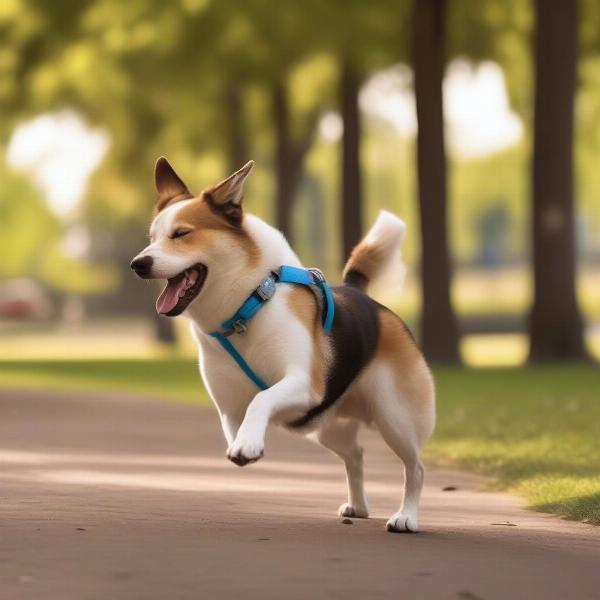Dog shock collars with GPS are increasingly popular tools for dog owners seeking to enhance training and ensure their pet’s safety. This guide will explore the functionalities, benefits, ethical considerations, and best practices for using these collars responsibly. Understanding the nuances of these devices is crucial for maximizing their effectiveness and minimizing potential harm.
Understanding GPS Dog Shock Collars
A GPS dog shock collar combines the location tracking capabilities of a GPS tracker with the training features of a shock collar. These collars allow you to monitor your dog’s location in real-time, often through a smartphone app. The shock function, also controllable remotely, delivers a static correction intended to deter unwanted behaviors.
These collars can be valuable tools for containing dogs within designated areas, training for recall, and curbing excessive barking. However, it’s essential to use them responsibly and understand their potential impact on your dog’s well-being.
Benefits of Using a GPS Dog Shock Collar
GPS shock collars offer several advantages, including improved safety and enhanced training capabilities. The GPS feature allows you to quickly locate your dog if they escape, preventing potential accidents or getting lost. The shock function can be used to reinforce commands and discourage undesirable behaviors like chasing cars or straying too far.  Dog Wearing a GPS Shock Collar in a Park
Dog Wearing a GPS Shock Collar in a Park
For dogs with a strong prey drive or a tendency to roam, these collars can be a vital safety net. The ability to administer a correction remotely can be particularly useful in situations where verbal commands are ineffective.
Ethical Considerations and Responsible Use
While GPS shock collars offer benefits, their use involves ethical considerations. The shock function, if misused, can cause pain and anxiety. It’s crucial to prioritize positive reinforcement methods and only use the shock function as a last resort. Always start with the lowest stimulation level and gradually increase only if necessary. gps shock dog collar
“It’s essential to remember that these collars are tools, not solutions,” says Dr. Emily Carter, a certified veterinary behaviorist. “Proper training and understanding your dog’s individual needs are paramount to successful and ethical use.” Never use a shock collar on a puppy or a dog with anxiety or aggression issues, as it can worsen these problems.
Choosing the Right GPS Dog Shock Collar
Selecting the right collar involves considering factors like your dog’s size, temperament, and the specific features you need. Look for collars with adjustable shock levels, a long battery life, and a reliable GPS signal. gps shock collar for dogs
“Consider the terrain you’ll be using the collar in,” advises John Davis, a professional dog trainer. “Some collars perform better in dense vegetation or hilly areas than others.” Waterproofing is also an important factor if your dog enjoys swimming.
Training with a GPS Dog Shock Collar
Start by familiarizing your dog with the collar and ensuring a proper fit. Pair the collar with positive reinforcement techniques like verbal praise and treats. Introduce the shock function gradually and only use it to interrupt unwanted behaviors, not to punish.
“Consistency is key,” adds John Davis. “Use clear and consistent commands, and always reward desired behaviors.” Regular training sessions and patience are essential for achieving positive results. dog gps and shock collar
Conclusion
GPS dog shock collars can be powerful tools for dog training and safety, but responsible use is crucial. Prioritize positive reinforcement, understand your dog’s individual needs, and always use the shock function ethically and as a last resort. Choosing the right collar and implementing consistent training methods will maximize the benefits and ensure your dog’s well-being. gps shock collars for dogs
FAQ
- Are GPS shock collars safe for my dog? When used responsibly and according to manufacturer guidelines, they can be safe. Misuse can lead to pain and anxiety.
- How do I choose the right shock level? Start with the lowest setting and increase gradually only if necessary. Observe your dog’s reaction carefully.
- Can I use a shock collar on a puppy? It’s generally not recommended to use shock collars on puppies.
- What if my dog has anxiety? Shock collars are not suitable for dogs with anxiety or aggression issues.
- How often should I train with the collar? Regular, short training sessions are most effective.
- Are there alternatives to shock collars? Positive reinforcement training methods, like clicker training, are often preferred.
- What should I do if my dog doesn’t respond to the collar? Consult with a professional dog trainer or veterinary behaviorist.
ILM Dog is a leading international online resource dedicated to providing dog owners with expert advice and information on all aspects of dog care, including breed selection, health, training, nutrition, grooming, and much more. We are committed to promoting responsible pet ownership and helping you build a strong, loving bond with your canine companion. For expert guidance and tailored advice, reach out to our team at [email protected] or call us at +44 20-3965-8624. ILM Dog is here to support you every step of the way.